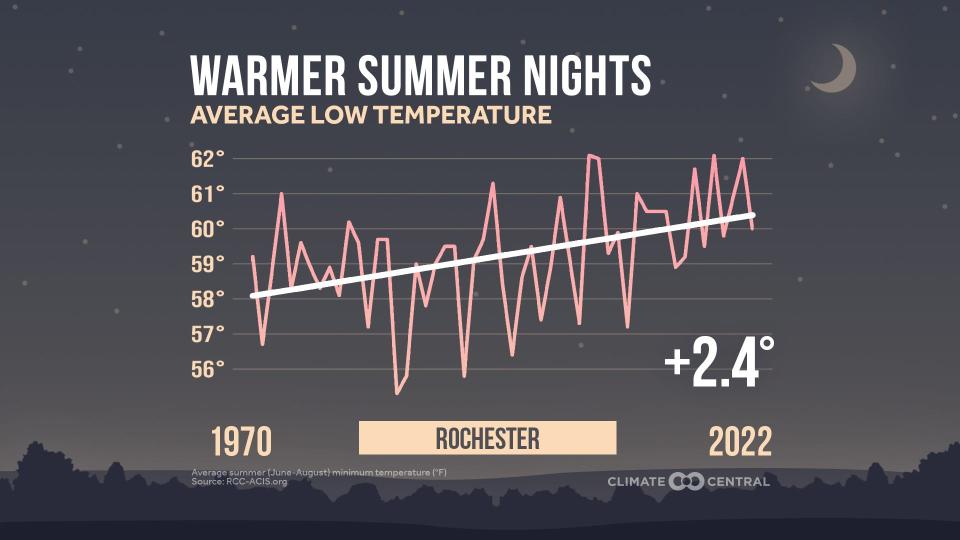For two consecutive days, Rochester has seen record-breaking temperatures.
It hasn’t been during the heat of the day, despite the mercury rising above 90 degrees. Instead, those record highs have been overnight, setting marks for the highest minimum temperature on June 18 and 19. That high minimum temperature contributed to this June 19 setting the highest average temperature for the day as well, according to the National Weather Service in Buffalo.
Summer lows are getting warmer
The minimum temperature of 73 degrees on June 19 was just 5 degrees cooler than the normal high and 15 degrees warmer than the normal low.
Average minimum temperatures from June through August have warmed 1.64 degrees in the contiguous United States since 1895, according to NOAA. A review of average summer minimum, or nighttime, temperatures by Climate Central found they warmed in 230 of 241 U.S. locations from 1970 to 2022.
Rochester was no exception, with summertime low temperatures warming 2.4 degrees over that span.

Health risks of high nighttime temperatures
Warmer overnight temperatures can limit recovery after hot days, leading to more heat stress and related health risks, especially among vulnerable populations, according to Climate Central. The groups most at risk from extended heat include children, people experiencing homelessness, older adults, people with pre-existing conditions and low income communities, according to the National Integrated Heat Health Information System.
On June 18, New York and New Jersey saw 190 emergency department visits for heat-related illness per 100,000 visits, according to the Centers for Disease Control Heat and Health Tracker.
Studies have shown that rising temperatures can erode sleep, mainly through people going to sleep later, though the impacts are felt more strongly in lower income countries and older adults. A study of populations in three Asian countries between 1981 and 2010 found excessive heat increased mortality risk.
More: What’s the best temperature to set your A/C at during heat wave?
Climate change and heat waves
Heatwaves are becoming more frequent and stronger in many parts of the world as a result of human-caused climate change, according to World Weather Attribution. While hot extremes have been attributed to manmade factors in much of the world, central and eastern North America are among the regions where there’s low agreement on those impacts, according to the 2023 report from the Intergovernmental Panel on Climate Change.
While this current heat wave has been stifling with the heat index — a measure of air temperature and humidity — topping 100 degrees, there has not been a significant change in heat wave intensity or frequency in Rochester. Those findings are based on data between 1961 and 2021 from the U.S. Environmental Protection Agency. Buffalo has, however, seen a statistically significant increase in heat wave frequency over the same span. There are now 2 more heat waves per year in Buffalo than when the data was first gathered 60 years ago; Rochester has seen an increase of less than one over the same span.
More: Water park safety tips: Must-know advice for NY attractions
The same data shows that heat waves are happening:
-
More often, with the average frequency in 50 major metros increasing from twice per year to six times per year.
-
Longer, with the average duration increasing from three days to four.
-
Across a longer period of time, with the heat wave season lasting an average of 49 days longer than in 1960
-
With greater intensity, with the average temperature above the local threshold during heat waves increasing. Heat waves are defined locally as three or more days with a heat index above 95 degrees, according to the Weather Service.
Historic heat waves
The most severe heat wave in recorded U.S. history came during the 1930s, coinciding with the Dust Bowl, according to the EPA. The eponymous dust storms were caused by farmers abandoning soil conservation practices amid low crop prices and high machine costs, along with a prolonged drought.
The Great Plains, devoid of vegetation and soil moisture, produced excessive heat that was funneled into the Great Lakes region by a ridge of high pressure, according to the Weather Service. The two hottest days in Rochester history came on July 9 and 10 of that year.
There have been 13 consecutive record-breaking months for average temperature worldwide. For the planet, last summer (June, July and August) was the hottest on record.
In Rochester it was cooler but close to normal in Rochester in 2023 for June and August by all measures and in July by average high and average temperature. There was a single day, July 6, above 90 degrees for the meteorological season.
This year, there have already been three (consecutive) days warmer than 90 degrees, with most of the season, including all of July and August, yet to come.
— Steve Howe covers weather, climate and lake issues for the Democrat and Chronicle. An RIT graduate, he returned to Rochester after working around the state and in Utah. Share with him at [email protected].
This article originally appeared on Rochester Democrat and Chronicle: Rochester sets record-breaking overnight temperatures for two days
Source Agencies


